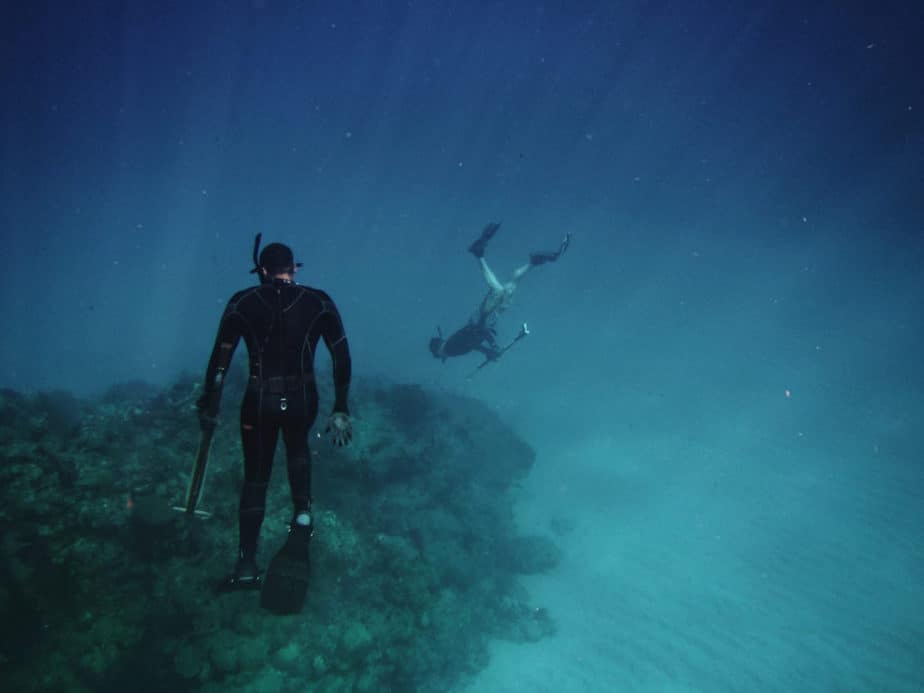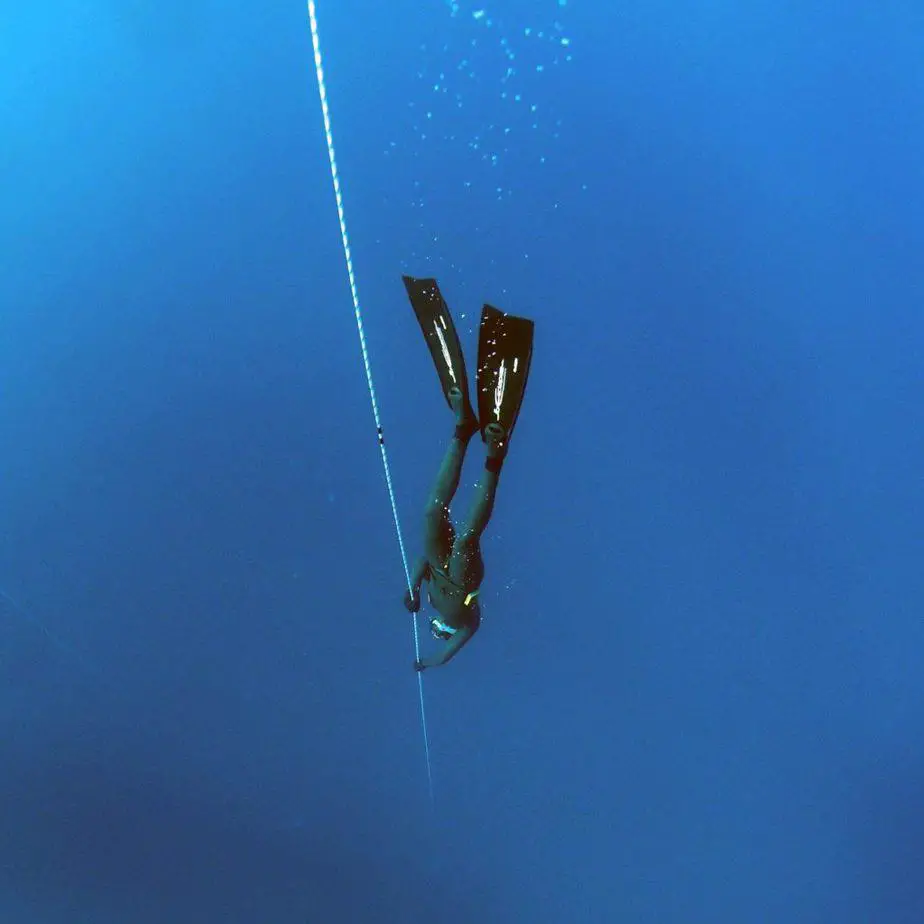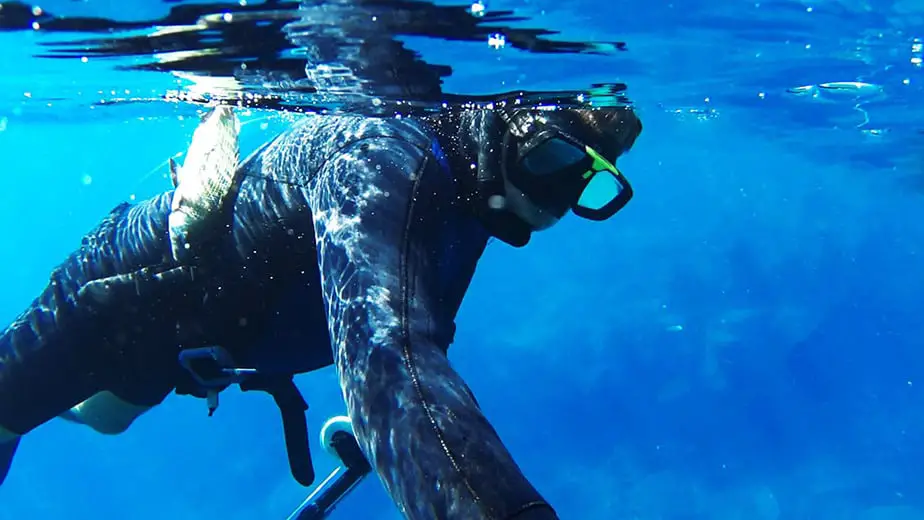Getting the best freediving weight belt is not as easy as it seems. Unfortunately, there is a trap that beginners often fall into when shopping for a freediving weight belt. This mistake will limit your abilities as a freediver by causing you to lose speed and agility while underwater.
Furthermore, it will result in a poor freediving experience and may even result in an emergency in rare cases. How could a freediving weight belt cause so much trouble, you ask? Sure it can, if you buy one made out of the wrong material.
If you are serious about freediving and spearfishing, the only type of weight belts you should invest in are rubber weight belts. Rubber is the ideal material because it can stretch with your diaphragm as you breathe. Other weight belts will simply restrict your airway and prevent you from reaching your potential.
There are many more reasons why you should invest in a rubber freediving weight belt, and in this article we will discuss the best ones and what criteria to consider when shopping for them.
Our Top Picks:
Purpose of a Weight Belt
Before we talk about which type of weight belt is the best, you should know the reason why freedivers even need a weight belt in the first place is to offset the positive buoyancy caused by the neoprene wetsuit and freediving fins.
The neoprene material that freediving wetsuits and fins are made from is filled with air bubbles, making them naturally buoyant (in other words, you will constantly float). As a freediver or SCUBA diver, this means you will be fighting against the positive buoyancy unless you add weights to help you reach neutral buoyancy (you are neither floating or sinking).
There are various weighting systems such as weight vests and neck weights, but the most common setup is using a weight belt with small weights to achieve neutral buoyancy.
Why Use a Rubber Weight Belt?
There are two types of freediving weight belts: nylon and rubber. A weight belt constructed from nylon is lightweight, durable, and affordable. It sounds pretty good, right? However its one major downside is too big of a downside to ignore: it doesn’t stretch. On the other hand, a rubber weight belt stretches as you breathe and move around.
With a nylon weight belt, you will limit your freediving potential by restricting your breathing and impeding your finning technique. During your pre-dive, you won’t be able to inhale as much oxygen and therefore your dives will be much shorter. Unfortunately, the market is littered with nylon freediving weight belts. Avoid them at all costs.
What you should aim to get are rubber weight belts. They have some minor downsides, such as being harder to secure the weights onto them. However, the benefits they provide are too great to pass up if you are a serious freediver. Here’s a few reasons why.
It Doesn’t Restrict Your Breathing

Rubber weight belts will allow you to maximize your pre-dive breath-up so that you can have the most oxygen in order to dive as long as you can without hindrance. And to achieve this, you must be able to inhale deeply into your diaphragm.
By not breathing into your diaphragm, you are not maximizing the amount of oxygen that can fill your lungs. In other words, without this technique all of your dives will be shorter and shallower than they could be. How does the material of the weight belt affect your breathing?
Simple. With a stiff nylon weight belt strapped on, you will not be able to fully inhale into your diaphragm since nylon does not stretch. Think back to the Victorian era when women wore tight corsets, and a nylon weight belt is something like that.
On the other hand, a rubber weight belt does stretch as you inhale. This allows you to maximize the amount of oxygen your lungs can inhale in order to fuel your body for the next dive. Honestly, this reason alone is already more than sufficient to recommend getting a rubber weight belt over a nylon one.
All of these additional reasons are just icing on the cake.
It’s More Comfortable
While in the water you must stay relaxed, calm, and comfortable whether you are freediving, SCUBA diving, or even snorkeling. If you feel uncomfortable, it will distract you, affecting how far you can dive and make it hard to enjoy the sport.
Wearing a weight belt made from something as rigid and inelastic as nylon even for just a few minutes will cause you to feel uncomfortable and restricted. This only gets exacerbated the deeper you dive and the water pressure changes affect you even more.
As things keep going wrong, you may start to feel anxious, and this can be quite dangerous indeed. As you know, stress will elevate your heart rate and cause you to panic. It will cause you to consume your oxygen supplies faster and potentially make mistakes you wouldn’t normally make.
By wearing a weight belt that can compress and stretch comfortably as you dive deeper underwater, a.k.a. a rubber weight belt, you’ll be able to concentrate all of your efforts on conserving oxygen and properly finning in order to reach deeper depths.
It Allows Greater Freedom of Movement
As you’re finning, you may feel your rubber weight belt stretching out to accommodate your waist and hip movements, letting you move with the proper range of motion in order to jet through the water.
On the other hand, a nylon weight belt will dig into your wetsuit and skin with its rigid material. In addition to restricting your breathing, it also limits your movements and slows you down, which is yet another way that it contributes to ruining your freedive.
In order to fin in comfort with perfect technique, you should definitely wear a rubber weight belt as opposed to a nylon weight belt. Now that you know why you should invest in a rubber weight belt, the question is which ones? Below, we will go over our picks for the best rubber weight belts for freediving.
Best Weight Belt for Freediving – Our Top Pick
Riffe Rubber Weight Belt
- Total Load Control: Fully adjustable 54-inch (137cm) long x 2mm thick rubber belt lets you customize the perfect weight amount and distribution up to...
- Built Strong and Secure: Glass-filled nylon cam-lock buckle paired with an inner ribbed 2-inch wide belt prevents shifting and retains weights...
- Fast Ditch for Safety: Quick-release lever enables instant detachment of the belt for emergency surfacing situations - just pull for fast ditching.
The Riffe rubber weight belt is one of the top choices currently on the market. It is made from a highly flexible rubber that will accommodate the natural curves of your body which is necessary in order to maximize pre-dive breathing. Furthermore, the belt has a quick-release buckle just in case you need to rapidly return to the surface during an emergency. Let’s go over each feature in more detail.
Stretchable Rubber Material
The high-quality rubber that the Riffe is constructed of is ergonomic, comfy, and feels like you’re wearing a second layer of skin around your midsection. Thanks to how flexible and dynamic it is, you will never feel like your movements or breathing is restricted which contributes to the “second-skin” feeling.
It will bend as you bend. Furthermore, the stretchable, lightweight rubber will ensure that your hydrodynamics are not negatively impacted so that you can jet through the water to set new personal bests.
Quick Release Buckle
You never know when an emergency strikes and you need to surface ASAP. With the help of the cam-lock glass-filled nylon buckle, you can quickly remove the belt in one simple motion.
With just the flick of the hand, you can eject all of your dive weights and swim back without being encumbered. This buckle not only looks stylish, but you can rely on it in a life-or-death situation.
Highly Adjustable
Getting the perfect fit is possible with the Riffe rubber weight belt. Unlike most belt buckles which are constrained by the spacing between each pre-set hole in the belt, the Riffe weight belt does away with this issue completely.
Instead of inserting the buckle tooth through the holes, the Riffe weight belt buckle allows you to fasten it to your exact tightness. You never have to deal with wearing a belt that is either too tight or too loose; you can finally get one that fits just right.
Corrosion and Rust Resistant
For all the flack we’ve given nylon, we have to give credit where it’s due. The nylon buckle of the Riffe weight belt is very durable. Salt won’t wear down the belt’s natural shape or reduce the buckle’s strength. It’s not going to rust either. When you buy a Riffe rubber weight belt, you buy it for life.
Weights Won’t Move (Until You Release Them)
Rubber naturally has a high friction coefficient which keeps the weights from sliding around the belt as you’re diving. What’s more, the belt also has horizontal ribbing to further reduce any movement and act as a second layer of defense to keep the weights secure.
Specifications
The Riffe rubber weight belt is 54” long by 2” wide and has a 20lb weight capacity. In other words, almost everyone reading this can use this. You can even cut the belt down to size if you so choose.
Overall, the Riffe rubber weight belt is a highly affordable, high-quality belt that’ll help you maximize your freediving potential. Furthermore, it is durable and will last you a lifetime. You can get yourself one by clicking here.
As for weights to go with the belt, we recommend this one. They will fit snug and will not shift around as you dive.
Scuba Choice Weight Belt – Best Marseilles Weight Belt
- Available size: 53" (1.3M), 61" (1.5M)
- Rubber belt self-compensates to changes in wetsuit's thickness at different depth
- Sturdy stainless steel buckle.
If you’re not happy with clasp style buckles, then the Scuba Choice freedive weight belt should be right up your alley. It features a classical weight belt design with the tried and true stainless steel buckle and holes in it.
While it’s easier to open, you have to be careful about the length of the pre-drilled holes in order to make sure that it fits your hips. With its durable yet stretchy material, you can easily fit over 20 pounds on it without sliding around. This stretchy belt will remain secured on your hips and provide you with the neutral buoyancy that you need.
Cressi Elastic Weight Belt – Best Stainless Buckle Belt
- The Premium Elastic Rubber Belt is manufactured with a high stretch rubber to keep your weights comfortably in proper position during ascents and...
- The quick-release stainless steel buckle provides instinctive and rapid emergency release.
- The buckle pin passes through, is very strong and is riveted at both ends.
You can’t go wrong with a trusted brand like Cressi. Here, you have an example of a weight belt with a stainless buckle. This offers the same advantages as a plastic buckle weight belt like the Riffe belt above. In addition to that, stainless steel buckles are even more durable and easier to unclip, though slightly more expensive.
What to Look for in a Freediving Weight Belt
Buckles
How do you know if one rubber weight belt is better than another? Start by examining the buckles. There are two types to choose from: the clasp type, or the regular pin-through-hole type that is sometimes referred to as the Marseilles type buckle. Let’s go over their pros and cons.
Clasp Buckles
Clasp buckles are made from glass-filled nylon or stainless steel. They come with quick-release protection, so if you ever find yourself in an emergency you can lift up the clasp and slide the belt off immediately.
The main advantage of clasp buckles are how adjustable they are compared to the pin type. When you find the exact tightness you like, just clamp the buckle down and you’re done. With the pin type, you can end up in an awkward situation where one belt hole is too tight, but the next one up is not tight enough.
Marseilles (Pin) Buckles
Marseilles buckles are more secure and durable than the other types, while still giving you the option of a quick-release switch. The moment you pull on the free end, the spring-loaded pins on these buckles will eject out of the hole and stay open so they won’t get caught on the belt again.
If you choose a belt with a pin style buckle, it is important to look for any reviews mentioning how stretchy the belt is. If it is stretchy enough, you can potentially stretch the belt just enough that it can reach the next hole to ensure a tighter fit. Just make sure you aren’t constricting yourself too much, otherwise you will affect your breath-ups.
Diving Weights
When it comes to diving weights, you can choose between uncoated lead weights or vinyl-coated diving weights. Either one can work, just make sure that they aren’t sliding around in your weight belt even if you don’t have a weight keeper. Dive weights can come in weights between 1lb to 12lbs.
Silicone Weight Belts
Recently, silicone weight belts have entered the market. Though rubber weight belts are still the most popular choice for freedivers, silicone weight belts may soon change that because they have some slight advantages.
For starters, they are stretchier than rubber, which only makes the weight belt fit even better and more comfortably. Furthermore, silicone weight belts are even more durable than the alternatives.
They are resistant to UV rays, salt, chlorine, ozone, and heat. In fact, silicone’s operating temperature range is -60C to +315C, both of which are temperatures you would be unlikely to encounter while freediving. The downside of silicone weight belts is their price, which is why rubber weight belts will probably still remain the recommended choice.

How to Wear a Freedive Belt
A weight belt will afford you no advantages if you wear it improperly. You should wear your freediving weight belt around your hips to ensure your breathing remains unimpeded. Wearing it any higher and you could restrict your airflow.
Another reason to keep the weight belt by your hips is it can seal up the bottom of your wetsuit jacket and prevent water from entering if you are wearing a two-piece wetsuit.
Next, you should be using small weights with your weight belt which allows you to evenly spread the weight for added comfort.
Most freediving weight belts are designed with a “one-size-fits-all” approach. In other words, they are probably too long for you and you are expected to slice off any excess length you don’t need. A mistake beginners often make is they cut the belt too short.
Instead, you should leave a little bit of extra length behind just in case you want to wear a thicker wetsuit in the future. Some brands offer more than one size, but keep in mind when buying: if a belt is too long, you can always cut some length off, but you can’t make a shorter belt longer!
Weight Belt Accessories
Correctly adding weight to your belt is a necessary skill to learn as a freediver if you are committed to improving and reaching your potential. In addition to knowing how much weight you should add, you might want to consider investing in these weight belt keepers.
You should consider looking into getting weight belt D-rings which give you the option to hang small accessories off of (such as a dive knife or torch). They also double as weight keepers (don’t you love it when things work out like that?) so if you want to keep your hands free while diving, give it some thought.
Best Freediving Weight Belt Recap
When selecting a weight belt for freediving, make sure to avoid nylon weight belts at all costs. You should look for rubber or silicone weight belts. Freediving weight belts need to be stretchy and comfortable. If you get one that’s too stiff, it will restrict your diaphragm and your movements, making it impossible for you to perform at your full potential.
With a stiff nylon weight belt, you will ultimately be incapable of freediving for as long, nor will it be as comfortable as a rubber weight belt. You also need to consider how easy the quick-release mechanism is to operate. It should be possible to quickly detach the belt from your body easily with just one hand.
The belt should have enough grip to hold onto the dive weights so that they aren’t sliding around your hips. You can get additional accessories, such as weight keepers or D-rings to hold onto smaller accessories, which can also double as dive weights themselves.
You can cut the belt down to size if it’s too long, however leave some extra length just in case you ever decide to wear it with a thicker wetsuit. When used in conjunction with a freediving line and buoy as well as a dive watch, then you will be diving in the most safe environment possible.
Last update on 2024-04-02 / Affiliate links / Images from Amazon Product Advertising API




